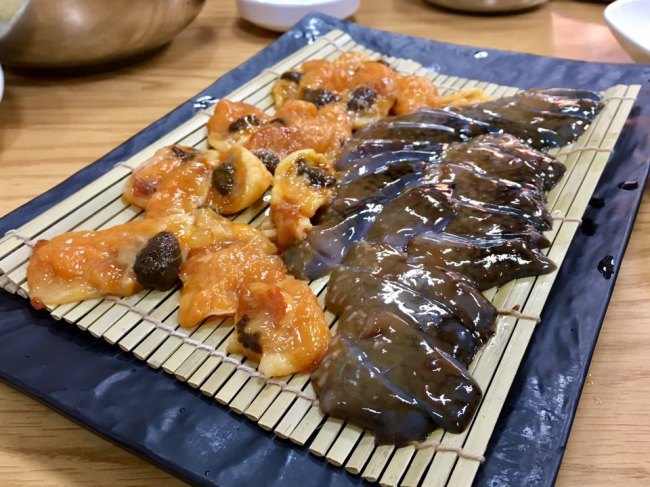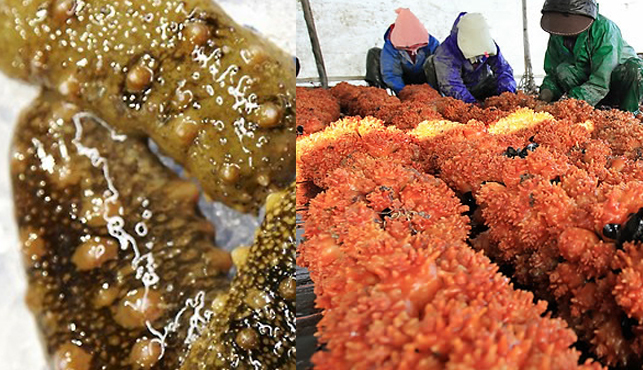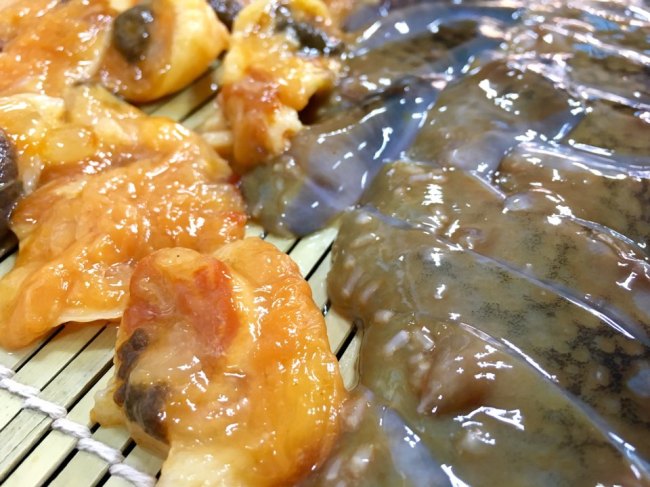Though famous for raw fish, Korea’s seafood restaurants don’t dish out only fish sashimi. There are many more on the menu, including some that do not look mouth-watering but prove to be unexpected delicacies.
 |
Meongge (left) and haesam chopped into edible pieces. (Photo by Im Eun-byel / The Korea Herald) |
Meongge is one of them. It’s sea pineapple, a type of sea squirt, whose shape strongly resembles a grenade with small fiery-looking bumps. It is red and rubbery and when squeezed, the bumps squirt out water.
As meongge is often farmed in the warm ocean bed, Tongyeong in South Gyeongsang Province is famous for dishes featuring meongge. More than 70 percent of meongge in Korea originate here.
The creature is usually eaten raw, and the rubbery coat doesn’t play a big role in eating as it is fully removed when served. Diners only face the watery orange flesh, sliced into edible pieces. The texture is soft and slippery, dancing when put into the mouth.
When meongge is chewed, it emits a unique, marine fragrance. The taste is strong with a hint of bitterness, the aftertaste lingering on the palate for a while. It can be eaten with chili paste, but to enhance the unique flavor and the scent, salted sesame oil sauce is recommended.
 |
Haesam (left) and meongge (Yonhap) |
 |
Meongge (left) and haesam chopped into edible pieces. (Photo by Im Eun-byel / The Korea Herald) |
Sea cucumbers are another surprise treat. Called “haesam” in Korean, meaning “ginseng of ocean,” the name of the weirdly-shaped sea creature hints at its high nutritional value. Haesam may look similar to a cucumber, but it is thicker and chewier. The black outer skin is shiny and sleek with bumps.
As the skin isn’t removed, the saltiness of the ocean (or at least of the water tanks at seafood restaurants) remains. Except for the saltiness, haesam doesn’t have a definite taste or odor. But the hard yet soft texture, similar to the cartilage of pig or chicken, provides a great pleasure for foodies. In fact, the fresher it is, the harder it will be to bite.
Like meongge, haesam is served raw. It is difficult to grab the slippery pieces of haesam using chopsticks. The sea creature is usually enjoyed with chili paste, as it has a relatively mild taste.
By Im Eun-byel (
silverstar@heraldcorp.com)







![[Exclusive] Hyundai Mobis eyes closer ties with BYD](http://res.heraldm.com/phpwas/restmb_idxmake.php?idx=644&simg=/content/image/2024/11/25/20241125050044_0.jpg)
![[Herald Review] 'Gangnam B-Side' combines social realism with masterful suspense, performance](http://res.heraldm.com/phpwas/restmb_idxmake.php?idx=644&simg=/content/image/2024/11/25/20241125050072_0.jpg)

